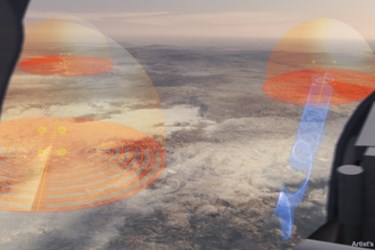Increasing Use Of EWs Posing Challenges To Global Aviation

By John Oncea, Editor

The use of electronic warfare in Ukraine and the Middle East is having its desired military effect. But it also is having an unintended effect: the disruption of commercial aviation.
Remember 2013? Mark Zuckerberg tried to buy Snapchat for $3 billion but his offer was refused and Instagram introduced video sharing. Apple was busy, too, releasing the iPhone 5s and iPhone 5c, as well as the iPad mini 2. Hackers were attacking news organizations, major tech companies, and retailers left and right, and wearable technology moved from the hype stage to the prototype stage.
Meanwhile, the Jersey Jetway GPS Jammer operated an illegal jammer in order (apparently) to defeat the GPS tracking device his employer had installed in his pickup truck, according to CommLawBlog.
Gary Bojczak’s “downfall occurred when he drove near Newark Liberty International Airport and his jammer caused interference to a GPS system being tested for aircraft operations,” CommLawBlog writes. “That kind of interference tends to get the authorities’ attention fast. Mr. Bojczak incurred a proposed fine from the FCC of $31,875.”
Bojczak used the illegal GPS jamming device in his pickup truck to hide his whereabouts from his employer. The FCC says that the man's use of the GPS jammer repeatedly caused harmful interference to the airport's GBAS.
Three years later Bojczak and the FCC entered into a consent decree under which if Bojczak admitted the violation and promised never to do it again, the FCC would reduce the fine to $2,360.
Flash forward 10 years. Evan Spiegel and Bobby Murphy still own Snapchat which is worth $26.1 billion while Apple debuted iPhone 15 Pro and iPhone 15 Pro Max in September. Hackers are still running rampant while wearable tech is becoming increasingly prevalent with smartwatches, fitness trackers, and VR/AR headsets becoming more common.
Unfortunately, I couldn’t find out where Bojczak is today, but jammers interfering with civilian flights are still in the news but at a much larger scale.
From Ukraine To Gaza, EW Is Being Used In Every Battlefield
Electronic warfare (EW) encompasses a range of technologies and tactics aimed at leveraging the electromagnetic spectrum to sense, protect, and communicate and/or, at the same time, disrupt, deny, and degrade an adversary’s ability to use these signals.
Lockheed Martin writes there are three major areas of EW, the first being electronic protection which is preventing a receiver from being jammed or deceived. The second is electronic support which involves sensing the electromagnetic spectrum. The third area is electronic attack which means to disrupt, deny, degrade, destroy, or deceive.
“Modern EW systems are highly complex, requiring equally sophisticated environments that can replicate threat environments accurately,” adds Northrop Grumman. EW systems are used in the air, to help ensure that strike aircraft can reach their targets and return home safely. It’s also used on the sea to protect surface ships from anti-ship missiles, providing early detection, signal analysis, and threat warning. Land forces use EW as well, protecting troops on the ground from device-triggered IEDs.
All of these uses of EW are occurring in the Middle East and Ukraine to various degrees of success. EW has been highly effective in Ukraine against small systems on both sides. Russian EW was highly effective in some areas though the density and effectiveness of its EW systems are inconsistent across the front. This allows the Ukrainians to continue to use drone-based reconnaissance-strike complexes to disrupt major Russian offensive operations.
In the Gaza-Israel conflict, Israel has used EW aircraft which can pinpoint devices that exchange data with low-orbit communication satellites and direct air-to-ground missiles against them. It also has increased GPS jamming to counter Hamas drone attacks.
Unintended Consequences
While things are going as planned on the battlefields, trouble is brewing away from them. According to the New York Times, EW “in the Middle East and Ukraine is affecting air travel far from the battlefields, unnerving pilots and exposing an unintended consequence of a tactic that experts say will become more common.”
European Union safety regulators have reported cases of planes losing satellite signals, flights being diverted, and pilots receiving false location reports or inaccurate warnings about flying close to terrain. The Federal Aviation Administration also has cautioned pilots about GPS jamming in the Middle East.
“Radio frequency interference — intended to disrupt the satellite signals used by rockets, drones, and other weaponry — spiked after Russia invaded Ukraine in early 2022 and has grown even more intense this fall in the Middle East,” the New York Times writes. “The interference can involve jamming satellite signals by drowning them out with noise or spoofing them — mimicking real satellite signals to trick recipients with misleading information.”
There has been some radio interference, but it hasn't caused any harm so far. However, Opsgroup – a group that monitors aviation industry risks and changes – has noted that GPS spoofing can't be detected by most aircraft systems, and as a result, these systems can't correct for it. This was demonstrated in September when an Embraer jet was headed to Dubai and almost entered Iranian airspace before the pilots realized that the plane was following a false signal.
Solutions to the challenges posed by jamming and spoofing are on the horizon. The European Commission's Galileo system is advancing in authentication measures to validate satellite signals and is at the forefront of countermeasures. In the meantime, Israeli tech innovators at InfiniDome are working hard to safeguard geolocation integrity. They are developing technology that can thwart the ubiquitous jamming devices, offering hope for stability in the skies. As electronic warfare tactics intensify, there is an increasing impetus to reinforce the resilience of our most relied-upon navigation systems.
